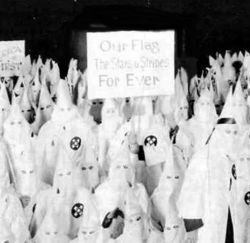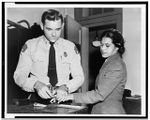Ku Klux Klub
- Three letters can stand for many different things, are you sure you weren't looking for any other KKKs?
The Ku Klux Klan was a successful television show which ran on the Fox network from 1865 to 1973. Featuring such wacky characters as Frank Hitchins, Jim Crow, Mama Belle, and the lovable Sgt. Whitey, it captured the minds of Americans for generations. The influence of this once mighty program is still felt in contemporary American culture.
From Humble Beginnings
After the American Civil War, many people wanted nothing but a return to "normalcy", something they could watch and see their traditional values reflected in. Enter Joseph E. Waterbury, a struggling writer trying to make it in the merciless world of Southern television. His vision was to create a show which would instill confidence in an America reeling from a Civil War, peacefully find the cause of their problems, and reflect traditional American values. He called his brainchild The Ku Klux Klan, and as to why, we've no idea. After pitching his idea to then head of Fox Alfred Williamson, Waterbury was given a chance to produce 3 episodes of his proposed show as a trial. Low on cash, Waterbury was forced to film his first episode The Wind of Change (1865) (Better known as Niggerfestival) in a local barn. However, his brilliant writing won him both critical and popular acceptance in every Southern state. Soon everyone in Alabama was saying the then famous line "Pardon me sir, but would you happen to have any roast nigger?", and the white, hooded Klaniform was being worn from Charleston to Richmond. People even began to imitate the instantly-recognizable "Strange Fruit" sketch at family picnics. Waterbury's program was a hit.
The KlanCentury
For the latter part of the 19th century, the program's popularity did nothing but spread. This is, of course, owing to Waterbury's visionary leadership and quality writing, which includes such memorable moments as Frank accidentally burning a Star of David instead of a cross, or Sgt. Whitey "mistakenly" beating a black man into unconsciousness, then "losing" him in the swamp on the way to the "hospital". Although its reception in the Northern United States was at best tepid, it did have something of a following there. Northerners were more apt to watch the show in secret, joking about it amongst themselves the next morning. The notable exception was in Indiana, where the KlanKraze was as alive as it was in Birmingham or Atlanta.

Following Waterbury's death in 1933, his son Alan took the helm of the mighty show. He inherited an empire of entertainment, but his leadership was best described as mediocre. He was notorious for his poor hiring decisions, most notably giving the Chief Writing position to Matthew Hunson, who was in fact illiterate. Another poor policy was his attempt to write about too many subjects, as is demonstrated by the 1949 3-episode series; "Jew-Jew Train...to Auschwitz" (1949), "I sure wish those Bead-Rattlers would go back to Italy" (1949), and "I'm not a bigot, but I really don't like Arabs" (1949). Under his management, the creative quality of episode titles slowly receded. The colossus which had once bestrode an entertainment globe saw its influence diminished.
Decline
In the 1960's, Americans began to turn away from the Klan in favor of newer, fresher programming. They saw the Klan's emphasis on country values and clean living as old fashioned and irrelevant in the age of free-love. There were great challenges to the Klan's ratings from such programs as Free-Love Fun-Fest, Happy Hippie Hour, and Liberal Laugh-In.(It was the great age of alliterations) The Klan's fan base diminished to its original southern stronghold, and advertisers began to take notice of its new weakness. However, the greatest challenge to Klan supremacy came from the NBC program The Civil Rights Movement. This dynamic new show captured the minds of Americans much as the Klan itself had done 100 years earlier. Stars such as Malcolm X, Rosa Parks, and Martin Luther King Jr. were beamed to televisions across the nation, and charmed their audiences with a degree of compassion and sincerity unseen in television before. It was thought for a time that the programs could co-exist peacefully, but when NBC switched its scheduling to air Civil Rights at the same time as Ku Klux Klan, it was clear a battle to the death was inevitable.
Ratings Battle
"Fussin' with Bussin" (1955)
The first skirmish occurred on December 1st, 1955, when NBC aired the soon to become legendary Rosa Parks bus sketch. The reaction across the nation was tremendous, as millions viewed the sketch again and again. Many diehard fans in Montgomery, Alabama (the scene for that episode) even refused to board the buses, believing it would be near sacrelidge. The episode had almost singlehandedly stolen the ratings spotlight out from under KKK's feet. But the KKK response was negligable. Rather than create fresh material, the Klan stuck to its old Cross-Burning sketch which had been born of the 19th century.
"Mama Belle Saves the School" (1957)
In 1957, the CRM aired a sketch in which nine students wandered into a school in an attempt to learn. The Klan, sensing an oppurtunity for a comeback, fired immedietely with Mama Belle Saves the School, in which Mama Belle led a group of white parents in attacking the children.(Contrary to popular belief, it is not in this sketch that the immortal "Give me a Hand" exchange was born. This one-liner involves one person requesting help, and instead recieving a severed hand. This sketch was pioneered in the 1946 episode "Darkies in the Closet") The episode won immediate critical acclaim, and sent the KKK back into the #1 ratings spot.
The Birmingham Incident (1963)
In 1963, CRM prepared a sketch which it believed would cause rioting set the world on fire(metaphorically of course). Its working title was "The Birmingham Marches", but it was never aired in final form. This is because as actor Martin Luther King uttered the final line of Scene III, ("Well damnit Floyd, if that's not incest I just don't know what is") he was attacked by three men wearing the KKK's famous conical hats. It was later confirmed that one of the attackers was none other than Adam Fuller, the actor who played Sgt. Whitey. Fuller was convicted of assault, and The Birmingham Incident was the final (metaphorical of course) nail in the coffin for KKK as a primetime show. After Birmingham, KKK was subjected to late-night slots, shoddy writing, and the stigma of Birmingham itself. It was formally cancelled in 1973.
CRM after Birmingham
Although some of its best performances lay ahead of it ("Oh Selma, why won't you just give me a pity date?" (1963), and the classic "Black Katz don't drink white milk" (1967) episode), the decline of CRM ironically lay in its own success. People consistently expected the show to raise the bar, and it just couldn't deliver under such pressure. The show was cancelled in 1981.
KKK today
Although KKK no longer resides on America's airways, it has found something of a cult following in its original base of support, Southern America. Today, OrKlanizations (Get it? Organiza...oh forget it. It wasn't my idea anyway.) continue to re-enact famous sketches and petition Fox for a new edition of the classic program. Also, there are numerous spinoffs which circulate around the internet. Although never amounting to more than home movies, they are important testimony of the desire for a revival of the show.


